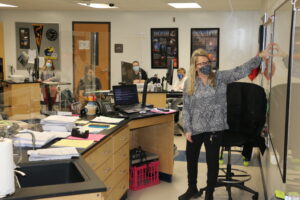By David Fleet
Editor
Brandon Twp- Tuesday morning Brandon High School physics teacher Lesley Hildebrand enlightened her geophysics class of freshman students that  at one time all telephones required a cord.
at one time all telephones required a cord.
“If you would have told me in your lifetime a phone would have needed a cord I would never have believed it,” said Hildebrand, providing an example of technology advancements over the last two decades to her class. “Now phones are all mobile. In 30 years you all will not be 50 yet—technology will advance even more.”
Hildebrand’s example of the changes in technology followed a class study of Perseverance landing on Mars. The Mars 2020 mission spacecraft, carrying the Perseverance rover, launched from Cape Canaveral, Fla, on July 30, 2020. The spacecraft arrived at Mars about six-and-a-half months later on Feb.18, 2021. The class discussion included several videos provided by NASA engineers along with a detailed discussion of the landing. The Perseverance, which will be on Mars for about three years will collect data such as weather data and return the information to earth.
Of the 21 students in class the majority agreed the next step will be a manned trip to Mars, it’s worth the money to go there but a permanent outpost on Mars was not going to happen.
The class discussion regarding the recent Mars landing and the impact on science continued during the week following the daily updates on the mission.
About two decades ago Anthony Lapp was also student at Brandon High School. Since his graduation in 1999, he served as a NASA Roboticist at the Johnson Space Center in Houston for many years.
“The recent Perseverance landing is mind-boggling,” said Lapp, during an interview with The Citizen last week. “Hitting such a small target from so far away requires tremendous planning, engineering prowess and mental might. To me this proves that the USA is still a front runner in space exploration, high technology and determination, and that NASA is still a premier science and technology leader. I’m beyond proud to have had the opportunity to work alongside such brilliant minds.”
Big science, without a direct plan for monetization is the exclusive realm of governments, he said.
“At first glance these ‘expensive’ space missions may seem like a waste, but the potential future gains are usually immeasurable,” added Lapp. “It is often noted that during and immediately following America’s successful moon program our country saw a burst of development in technology, science and computer industries. This initial increase in interest was directly fueled by money spent during the Apollo era to solve big problems. As Apollo ended this interest continued as legions of young smart engineers and technologists set out to create their own moon shots.”
Today we focus on Mars, he said.
“It’s close enough inside of our solar system to make it a practical target,” he said. “It only takes about eight months to reach and the surface conditions are manageable. Mars is a great place to search for early signs of life outside of Earth and previous missions have found potential evidence for this.”
Should we prove that life existed on Mars, or perhaps even evolved separately, the implications to modern biology and the related sciences would be immense, he said.
“The future technological developments that will be yielded from these explorations is unknown, but be certain that advancements in materials science, battery technology, robotics and communications all share their heritage with the space program.,” he said. “At $3 billion these missions are by no means cheap, but when compared to the US Military budget of approximately $600 Billion and American’s annual $7 Billion spend on potato chips it seems like a good value.”
